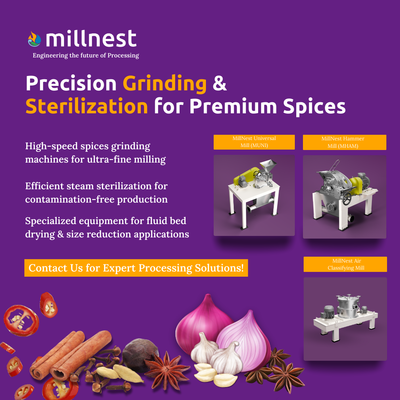|
Spice Processing 2.0: How Viksit Bharat 2047 & Budget 2025 Are Transforming India’s Spice Industry
India is at a defining moment in its industrial journey. As the world's largest producer and exporter of spices, the country has long been a global leader in spice processing. However, the landscape is shifting. With Budget 2025-26 paving the way for an agriculture-driven economy and Viksit Bharat 2047 setting long-term goals for self-reliance and global dominance, the spice industry must embrace modernization. The key challenge now is ensuring that increased production leads to enhanced value, efficiency, and sustainability.
At MillNest, we are driving this transformation. Our state-of-the-art grinding machines for masala, high-speed blenders machines, and pneumatic conveying systems are revolutionizing spice processing, ensuring compliance, efficiency, and sustainability. The time for change is now—Indian spice manufacturers must adopt cutting-edge technology to maintain global leadership.
Budget 2025-26: Reshaping Agro-Processing in India
The Union Budget 2025-26 has introduced game-changing policies aimed at strengthening India’s agricultural backbone, with direct implications for spice cultivation and processing. Here are the key highlights:
• National Mission on High-Yielding Seeds: Farmers now have access to climate-resilient, pest-resistant, and high-yield spice varieties. This will boost production but also increase the pressure on processing units to maintain quality and efficiency.
• Kisan Credit Card (KCC) Limit Increased: The government has raised KCC limits from ₹3 lakh to ₹5 lakh, giving farmers greater financial flexibility to invest in advanced cultivation techniques. This will lead to an influx of raw spices, demanding better grinding machines for masala, blenders machines, and pneumatic conveying systems to prevent bottlenecks and maintain output quality.
• Emphasis on Sustainable Agriculture: With policies promoting climate-resilient spice crops, processing facilities must align with sustainability goals—minimizing waste, optimizing energy consumption, and ensuring compliance with global food safety standards.
India’s Spice Industry: A Global Powerhouse in Need of Modernization
India dominates the global spice trade, producing 75 of the 109 recognized spice varieties and accounting for nearly 50% of the world’s spice exports. In 2024, India’s spice exports reached an impressive ₹36, 958.80 crore ($4.46 billion), and the demand continues to rise. However, challenges remain:
• Quality Concerns & Global Compliance: Despite its leadership, India’s spice exports have faced quality rejections from major markets like the EU, Singapore, and Hong Kong due to contamination issues and outdated processing methods.
• Increasing Competition & Rising Costs: Other spice-producing nations are rapidly modernizing, and Indian manufacturers must adopt energy-efficient, high-precision processing systems to stay ahead.
The only way to sustain India’s dominance in the global spice industry is through technology-driven modernization.
Why Upgrading Spice Processing is No Longer Optional
With rising production levels, traditional manual and semi-automatic processing units will struggle to keep up with demand. Key challenges include:
• Bottlenecks in processing due to outdated machinery.
• Inconsistent product quality, impacting exports.
• High operational costs leading to reduced profitability.
To address these challenges, spice processors must embrace automation and precision technology:
• Blenders Machines: Advanced blending systems ensure spices retain their natural oils, flavors, and textures, producing a superior end product. These machines also help in reducing processing time, standardizing quality, and improving energy efficiency.
• Grinding Machines for Masala: Modern grinding machines offer high-yield, low-energy processing, preserving essential spice compounds while maintaining precise particle control. This ensures better aroma, potency, and compliance with food safety standards.
• Pneumatic Conveying Systems: Manual spice handling increases contamination risks. Automated conveying systems enhance hygiene, reduce wastage, and improve efficiency in spice factories.
MillNest: Leading the Future of Spice Processing
At MillNest, we are revolutionizing the spice industry with cutting-edge solutions:
• Blenders Machines: Our high-performance blenders enable consistent mixing, reduced processing time, and minimal heat generation, ensuring that essential flavors and oils remain intact.
• Grinding Machines for Masala: Designed with low-energy, high-yield technology, our grinders maintain the natural potency and texture of spices, meeting global safety standards.
• Pneumatic Conveying Systems: By eliminating manual lab
|
|



